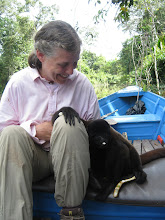Woke up bright and early and started my day off with nice conversation with an older gent, bilingual, who is also staying at the Hotel. Had a decent breakfast, which was included in the price of my stay.
Spent a bit of time scoping out some of the other cheaper hostals in town, and found a winner. La Patarshea has some english speaking staff, is way cheaper, has a lovely courtyard with hammocks & chairs for lazing about in.
Took a bit of time to cozy into said room, as I will be here at least a week. The price for this lovely little gem? About $15. per night.
Tarapoto, population 125,000 and known as "the city of palms" sits in a rich and lush valley, one low mountain away from the amazon basin proper. Agricultural exports include rice, bananas, avocados, cacao and coffee.
After a generous invitation by one of the english speaking staff, (I will no doubt be able to remember her name at some point in the next couple of days... why do I have sooo much trouble remembering names???) I headed off with a group of locals to a small nearby town, Lamas. Joining us was (Oh hell, I'll just call him Eddy until I get it right) a student that has agreed to spend a few days with me trying to knock some spanish into my head. While my hostess and her compadres were giving a class in tourism, culinary presentation to be exact, Eddy and I explored the town.
Lamas is located about 20 kms NE of Tarapoto, has a population of about 16,000 and is known as "the city of 3 floors", or "the city of 3 steps", depending on your translator. The lower area is populated by local indigenous Andean Quechua families who live life true to their Quechua heritage. The thick, okra coloured, thatched roof, "tapial" walls fell (made of stamped down mud) homes have solid wooden doors and no windows. The people believe that windows allow evil spirits to come into the house. Many of these homes have have large cracks in the walls caused by an 7.5 earthquake that shook the town in 2005.
The middle area consists of Quechua, but those not living so strictly according to their past. Here the home are brick / stucco and have windows. The some of the streets are paved with sidewalks and porches. Many of the buildings are new construction post earthquake.
The upper "step" is predominately Mestizo, descendants of the original mixed marriages between the Andean Quechua and their spanish conquerors. This area of town is much closer in feel and custom to that of other Latin-Peruvian towns. Here there is evidence of the push towards tourism, with hostals and restaurants.
We spend an easy couple of hours wandering up and down the streets. There is a slow and very friendly pace to this town. Lots of kids. Lots of dogs. I expressed interest in trying BBQ banana, and was promptly given one. Ditto the leaf wrapped, steamed plantain. All payment refused.
And the flowers... Leona, you would have thought you'd died and gone to heaven. A prolific rainbow of colour, pouring out from every nook and cranny. Some I recognized (at least 4 different colours of hibiscus) and some I had never seen before. As on my last trip here, growing everywhere in abundance (and to great size) were just about every tropical plant we nurse along in our homes.
We ended our wanderings by taking a mototaxi (little 3 wheeled wonders built around a motorcycle body) to a local ecco reserve / conservation centre. This great place showcases the flora that is being reforested in the area thanks to work done in conjunction with one of the American Universities... (or so I understand from Eddy´s try at translation). Here I learn more about the local organic coffee and cacau that is being raised and harvested through a local co-operative. Both have won awards. Indeed, the again FREE chocolate and coffee were some of the best I have ever tasted. Must find more detailed info about this.
There were murals drawn on the walls depicting the belief in the spirits of the various trees and vines, as envisioned during ayahuasca (a powerfully psychedelic South American brew) sessions. Wandering around the centre I came across many plants that have butterfly eggs attached under their leaves. Kinda cool looking things.
Got my first taste of driving over pitted, rainy season dirt roads. Brings to mind all the warnings I have read about 4-6 hour sections of road like this in the area I am thinking of visiting. Am wondering if my back would survive such an experience?? Are their enough pain meds in the world?
Interesting factoids:
Price of gas is the equivalent of $3.50 a gallon. Leaded of course.
Cellphones abound.
There is a new "Techno Andean" music. Very difficult to describe.
Saw my first Peruvian garbage truck picking up streetside trash this am. I wonder where it goes? Hopefully not straight into the river. Will have to enquire.
There is a new Nature reserve in the mountains abutting the town, which incidentally is where the cities water source comes from... I´m thinking this is probably a good thing.
The map of peru I bought through the SAEC was printed in 2000. Hmmm, probably been some changes to the roads since then.
Lonely Planet guide to Peru was printed in 2007. I KNOW there have been changes since then, because I keep coming face to face with the incorrect info. :{
Now that I have once again talked your eyes out... (and thanks to the incredible cup of coffee I drank at 7 pm) I think I will take another stroll around town. Really don´t want to call an end to this GREAT day I have had.
Mañana.
Subscribe to:
Post Comments (Atom)

No comments:
Post a Comment